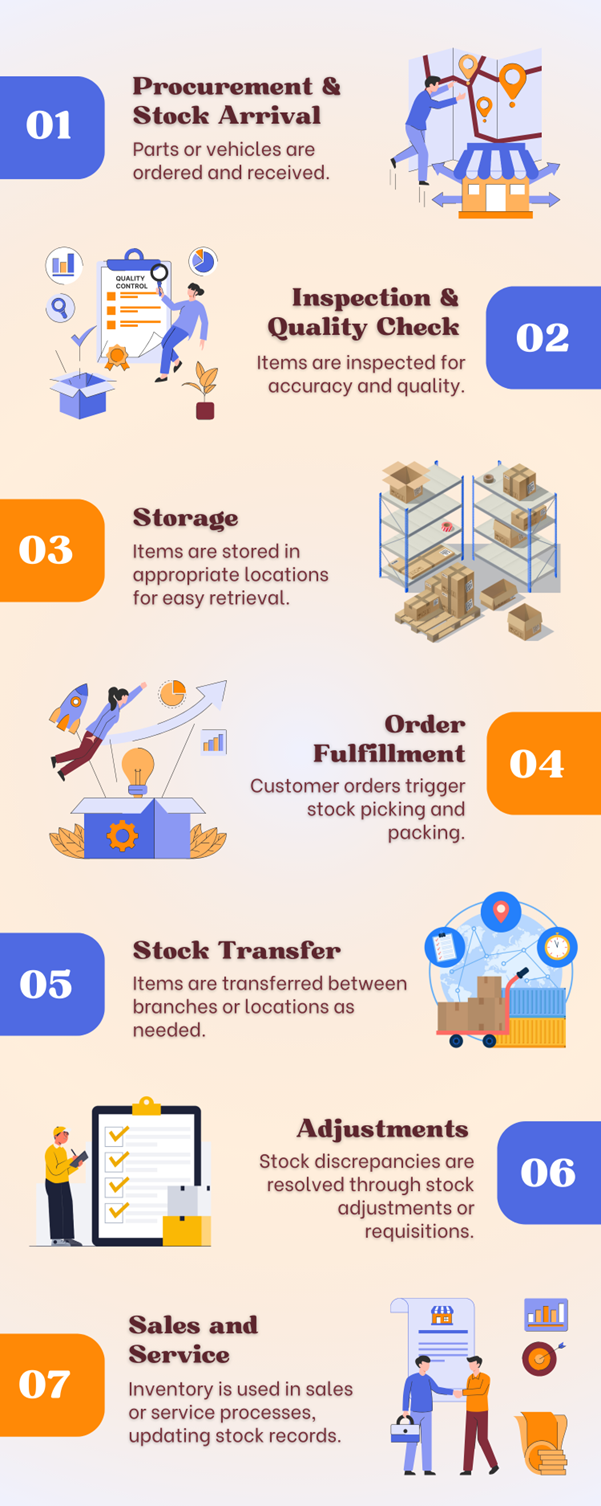Automotive Inventory Management: The Complete Guide

Behind every successful auto dealership inventory management system or service center is a robust Dealer Management System (DMS)—a centralized platform that streamlines operations, from sales to automotive inventory management. While customers see a seamless experience, dealers rely on auto inventory management software to automate processes, reduce errors, and keep business running smoothly.
At the heart of an efficient DMS lies one critical function: Inventory Management. Whether it’s tracking vehicles across showrooms, managing spare parts with auto parts inventory management software, or optimizing stock transfers, inventory accuracy directly impacts profitability.
The Hidden Challenge: Why Inventory Management Matters
The customer rarely sees what happens behind the scenes of a smooth vehicle purchase or repair experience. They walk into a dealership, ask for a model or a part, and expect quick answers and faster service.
But as a dealer or service center manager, you know the real challenge lies elsewhere.
Whether you’re managing hundreds of spare parts across locations, tracking inbound vehicle shipments, or ensuring the right part is available for urgent repairs, it all boils down to one thing: inventory management.
And yet, it’s one of the most overlooked operational pillars in the automotive business.
A study by MarketsandMarkets suggests that the automotive aftermarket management market will grow from $320.6 billion in 2020 to $430.4 billion by 2025, reflecting the increasing complexity and demand for better stock management solutions.
This article explores how smart inventory management software(1) can simplify dealership operations and help your sales team work more efficiently.
Let’s start with the basics.
What is Automotive Inventory Management?
Auto inventory management refers to the process of overseeing, tracking, and controlling the stock of vehicles, parts, and accessories within the automotive industry. This includes managing everything from vehicle parts to finished goods (vehicles themselves), ensuring that businesses can meet demand without overstocking or running out of necessary items. It’s a critical part of the supply chain and operations for automotive dealerships, repair shops, and manufacturers.
The goal of automotive inventory management software is to streamline the procurement, storage, and distribution of parts and vehicles. Efficient management not only helps in reducing costs but also ensures that customer needs are met promptly, reducing the risk of delays in vehicle repairs or sales.
Why Auto Inventory Management is Required?
Auto inventory management system keeps the business in sync with demand and customer requirements.
A vehicle that is out of stock when a customer wants to purchase is a lost opportunity. A non-existent spare component at a garage can cause delayed repairs, prolonged vehicle downtime, and unhappy customers. These moments directly affect revenue, retention, and operational performance.
Inventory balancing ensures that the proper vehicles and parts are on hand when and where they’re required. It prevents overstocking that immobilizes working capital and keeps from understocking that causes service downtime.
This process is critical across the automotive ecosystem:
- Dealers rely on accurate stock visibility to fulfill bookings, manage trade-ins, and support timely vehicle deliveries.
- Service centers depend on readily available spare parts to meet turnaround commitments and reduce wait times.
- Parts manufacturers need inventory control to streamline production, plan dispatches, and minimize surplus.
- Vehicle manufacturers (OEMs) manage large volumes of components and finished units across multiple hubs and sales channels.
- Logistics and distribution companies coordinate stock movement, documentation, and handling across branches or partners.
An inventory management system creates a framework where each of these players can function effectively without unnecessary delays or bottlenecks. In the sections that follow, we’ll look at how this system works, its key components, and how modern tools are shaping the future of inventory in the automotive industry.
Core Components of Inventory Management
Effective inventory management in the automotive sector relies on several core components:
1. Stock Tracking: Keeping detailed records of what is in stock, where it is stored, and when it needs to be replenished.
2. Stock Replenishment: A system to automatically reorder parts and vehicles before they run out.
3. Stock Control: Managing excess stock and reducing holding costs while maintaining enough inventory to meet demand.
4. Order Processing: Efficient systems to handle orders from customers, ensuring that the right items are delivered on time.
4. Returns Management: A process for handling returns of defective parts or unsold vehicles.
How the Inventory Process Works:
Automotive inventory management software is a step-by-step process that keeps everything moving in sync, from receiving vehicles and parts to delivering them at the right time and place. Each stage plays a role in keeping stock accurate, operations efficient, and customers satisfied.

1. Procurement
It all starts with understanding what needs to be ordered. Teams analyze customer demand, past sales, and seasonal trends to place orders for vehicles, spare parts, and accessories. Accurate planning avoids excess stock that sits idle and helps prevent situations where important items are missing when needed most.
2. Receiving and Inspection
Once items arrive, the next step is to check them thoroughly. This includes verifying quantities, checking for physical damage, and ensuring the received items match the original order. Every approved item is then added to the inventory system so that the records reflect the most current stock status.
3. Storage
After inspection, items are placed into storage. This stage is more than just organizing shelves or parking vehicles. It involves sorting everything based on type, usage, or model so teams can locate them quickly. For example, brake pads, engine oils, or headlights might be grouped separately. Vehicles may be arranged by fuel type, booking status, or brand.
4. Order Fulfillment
Whenever a customer books a vehicle or a service technician needs a part, the order fulfillment process takes over. Items are picked from inventory, packed where necessary, and handed over for delivery or installation. Having a reliable system in place ensures the right items are picked every time, helping avoid delays or rework.
5. Stock Transfers and Adjustments
In a multi-branch setup, stock often needs to be shifted between locations. This involves requesting stock, dispatching it, and then confirming receipt. Sometimes, adjustments are also required when items are damaged, returned, or found missing during audits. These changes are recorded to keep the system aligned with the actual stock on hand.
6. Service
Whenever an item is sold or used during a repair, the system instantly updates to reflect the reduced quantity. This real-time update helps avoid overselling, supports faster reordering, and maintains clarity across teams. When sales and service data flow directly into inventory records, there is less room for manual error.
This end-to-end process ensures that the right items are always available at the right time. It also helps different departments work together efficiently—sales, service, warehouse, and procurement teams all rely on this shared system to make fast and informed decisions.
Features in Auto Inventory Management System
Stock Transfers
Imagine a dealership group with multiple branches across a city. One location is seeing high demand for a particular SUV, while another has several units of the same model sitting idle.
With the stock transfer feature, the business can quickly move those vehicles from the low-demand location to where customers are actively asking for them. The same applies to spare parts, if the service center in Branch A runs out of brake pads, they can instantly arrange a transfer from Branch B, where stock levels are still healthy.
Stock Transfer Requisitions
This comes into play when staff need to formally request inventory from another branch. For instance, a service technician at the downtown branch realizes they’re out of a critical part needed to complete a repair.
They raise a requisition through the system, which notifies the nearest branch with available stock. It streamlines coordination and helps avoid the chaos of manual calls, emails, or paperwork.
Stock Transfer Outwards & Inwards
Let’s say Branch A sends three sedans and a batch of accessories to Branch C based on a transfer requisition. That transaction is recorded as an outward transfer for Branch A. Once Branch C receives the items, they mark it as an inward transfer—confirming that the right stock was delivered, in the right quantity and condition. This dual confirmation ensures inventory records on both sides stay accurate.
Sub dealer Stock Transfer
Suppose a dealer has smaller sub-dealers operating in remote areas. These sub-dealers depend on the main dealer for timely replenishment. Through the subdealer stock transfer feature, the main dealer can send parts, promotional items, or even demo vehicles to the sub dealer with proper documentation and tracking. This helps maintain service standards across the network.
Stock Adjustment Requisitions & Adjustments
Sometimes, mistakes happen parts get misplaced, damaged, or miscounted during audits. In such cases, teams can raise a stock adjustment requisition to correct the numbers. For example, if the system shows 10 oil filters in stock but the physical count reveals only 8, an adjustment requisition is submitted. Once verified, the records are updated to reflect the actual quantity. This avoids confusion and helps maintain trust in inventory data.
Issue Document
Dealers often participate in roadshows, vehicle exhibitions, or corporate campaigns. When a vehicle is temporarily assigned for such purposes, it’s tracked using the issue document feature. For instance, if two vehicles are sent to a weekend auto expo, the system logs when they were issued, who authorized the dispatch, and when they’re expected to return. It keeps event activities well-organized and prevents inventory mismatch.
Auto Ordering
The Auto Ordering Utility helps businesses plan demand and supply by forecasting sales and current stock levels. It recommends optimal reorder quantities and values for restocking, automating the purchase order process. For the FMS group, it ensures proactive, efficient procurement, minimizing the risk of overstocking or understocking and improving inventory management.
Kit & De-kitting Documents
Kitting involves bundling components together like a clutch repair kit, while de-kitting breaks them back into individual parts. A Kit De-kitting document tracks this movement, helping workshops manage part usage efficiently during repairs or special projects.
ABC-FMS Planning
Inventory can be classified using the ABC analysis and FMS matrix:
1. ABC Classification:
- A Category: High-value items with 80% sales contribution, requiring tight control
- B Category: Moderate-value parts managed with moderate control
- C Category: Low-cost items contributing 5% of sales, requiring minimal control
2. FMS Classification (based on movement):
- F (Fast Moving): Items sold regularly over 7 to 8 months
- M (Medium Moving): Items moved 5 to 8 times in recent months
- S (Slow Moving): Less than 5 movements in a defined period
This classification supports stocking decisions. High-value, fast-moving items are prioritized, while low-value, slow movers are kept lean to reduce holding costs.
Auto pick (Automated Stock Picking)
The Auto Pick automatically allocates spare parts in a single step, streamlining the picking process and saving time by reducing manual effort and errors.
Demand Planning
Forecasts are generated based on historical sales, seasonality, and current trends. For instance, wiper blades may see increased demand during monsoons. Demand planning ensures stock is prepared in advance.
Buy-One-Sell-One
It simplifies inventory management by automating the process of raising a purchase order for a part once it has been sold. This ensures that inventory levels are maintained efficiently and replenished promptly after each sale. By linking sales with procurement, this feature helps businesses streamline stock management and prevent stockouts, ensuring that items sold are restocked automatically based on demand.
Forecasting
The Forecasting feature predicts spare part sales over a defined period, enabling proactive planning and inventory optimization to meet future demand efficiently.
Before vs After Automation: KPI Improvement
| KPI | Before Automation | After Automation |
|---|---|---|
| Stock Visibility | Manual records, inconsistent | Real-time visibility across locations |
| Transfer Accuracy | Frequent mismatches | Documented, traceable transfers |
| Stock Availability | Manual check, delays | Predictive alerts, ready stock info |
| Customer Delivery Time | Delayed due to stock mismanagement | Faster turnaround |
| Operational Cost | Higher due to inefficiencies | Reduced with streamlined workflows |
Benefits of Having Automotive Inventory Management Software
1. Enhanced Stock Visibility:
Real-time monitoring of inventory enables companies to track stock levels and forecast demand correctly.
2. Fewer Overstocks and Stockouts:
Companies can have balanced inventory, with no tying up of funds in unsold inventory or missing sales from unavailability of parts or vehicles.
3. Improved Operational Efficiency:
With automation and streamlined processes, employees can concentrate on value-added activities, instead of manual tracking and order processing.
4. Cost Savings:
By reducing the likelihood of overstocking or stockouts, companies can eliminate unnecessary storage costs and lost sales.
5. Customer Satisfaction:
Quick order fulfilment and timely deliveries enhance the customer experience, resulting in repeat business and word-of-mouth.
Key Metrics and KPIs to Track
Inventory Turnover Rate:
Measures how quickly inventory is sold or used within a given period.
Days Sales of Inventory (DSI):
Tracks how many days it takes to sell the entire stock.
Stockouts:
Monitors the number of times an item is out of stock, which impacts sales and customer satisfaction.
Order Accuracy:
Ensures that customers receive the correct items, which affects customer retention.
Lead Time:
Tracks the time it takes to replenish stock from suppliers or other branches.
Best Practices for Efficient Auto Inventory Management
Managing auto inventory requires careful planning and execution. Here are some best practices to ensure efficiency in managing inventory:
1. Implement Real-Time Tracking Systems:
Using advanced tracking technologies, such as barcode scanners businesses can monitor their inventory in real-time. This reduces errors and ensures accurate stock levels at all times.
2. Regular Stock Audits:
Routine physical stock checks are crucial to ensure that the actual inventory matches the recorded data. Regular audits help identify discrepancies, prevent theft, and ensure that all parts and vehicles are accounted for.
3. Demand Forecasting:
Accurate demand forecasting helps predict inventory needs based on historical data and market trends. By analysing past sales data and seasonality, businesses can ensure they maintain optimal stock levels.
4. Automated Replenishment:
Implementing an automated inventory system can trigger reorders when stock levels fall below a predefined threshold. This reduces the risk of stockouts and helps maintain a consistent inventory level without manual intervention.
5. Centralized Data Management:
Centralizing all inventory-related data in a single system ensures that everyone within the organization has access to accurate, up-to-date information. It helps streamline operations and ensures better decision-making.
6. Supplier Relationship Management:
Building strong relationships with suppliers helps ensure timely deliveries and flexibility in stock replenishment. By working closely with suppliers, automotive businesses can reduce lead times and maintain consistent stock levels.
7. Efficient Stock Movement and Layout:
Organizing stock efficiently within warehouses and branches can speed up stock picking and reduce handling time. The use of clearly labeled shelves and designated areas for specific parts can further optimize the process.
8. Clear Stock Transfer Procedures:
Establishing clear procedures for stock transfers between branches or sub-dealers ensures that the process is quick and error-free. Automated requests and approvals can reduce the manual workload and speed up stock movement.
Centralized AI-driven Inventory Management
AI-powered inventory management systems enable businesses to manage inventory across multiple locations seamlessly. These systems optimize stock levels, automate reordering workflows, and offer real-time insights into inventory trends. By leveraging AI, businesses can receive intelligent recommendations for stocking the right products at the right time, reducing overstocking and understocking issues.
Key Benefits:
- Centralized Management Across Locations: AI unifies the inventory data from various locations into one system, giving businessesa comprehensive view of their stock.
- AI-driven Recommendations for Optimal Stocking: AI processes historical data, patterns, and demand projections to recommend the optimal amount of each product to hold.
- Real-time Insights on Inventory Movement: With AI, businesses have real-time visibility into the movement of inventory, enabling them to make preemptive decisions.
- Automated Reordering Workflows: AI allows companies to monitor inventory movement between various locations, ensuring timely and effective product and parts movement.
- Multi-location Visibility for Products and Parts: AI enables businesses to track inventory movement across multiple locations, ensuring the timely and efficient transfer of products and parts.
This approach results in better coordination, lower carrying costs, and enhanced customer satisfaction.
Excellon: AI-Powered Inventory Management software for Streamlined Automotive Operations
Excellon’s inventory management system is designed to simplify and strengthen stock operations across the automotive value chain. It enables accurate demand planning, real-time visibility, and intelligent replenishment, helping businesses maintain the right inventory levels without overstocking or shortages.
Powered by AI and automation, the system analyzes patterns, predicts demand shifts, and optimizes stock movements to reduce manual effort and errors. From procurement to fulfilment, every step is streamlined to improve coordination across locations and support business growth.
By aligning inventory workflows with sales and service demands, it ensures faster turnaround, lower carrying costs, and a more consistent customer experience.


